Abstract
Microcolonies were obtained by culturing cells of two human osteosarcoma lines (OHS and KPDX) and one human melanoma line (WIX-c) for either 24 or 72 h. The microcolonies were treated with either alpha-particle radiation emitted by the 211At-labelled monoclonal antibody (MAb) TP-3 or external beam X-rays. Survival of microcolonies was assayed by colony formation. Therapeutic gain factor (TGF) values were calculated for two survival levels, 50% and 20% microcolony regeneration (i.e. at least one cell in 50% or 20% of the colonies survived the treatments). The TGF values were affected by the specific activity of the 211At-MAb conjugate, the antigen expression of the cells and the size and growth pattern of the microcolonies. Treatment with 211At-TP-3 gave TGF values that varied from 1.3 +/- 0.4 to 4.5 +/- 0.7 (mean +/- s.e.). The antigen-rich OHS cell line had on average 1.6 times higher TGF than the antigen-poor KPDX cell line. The TGF increased significantly with colony size for the densely packed colonies of the KPDX cell line but not for the OHS cell line, which had colonies with cells growing in a more scattered pattern. Control experiments with the two non-specific 211At forms, free 211At and 211At-labelled bovine serum albumin, gave TGF values from 0.6 +/- 0.1 to 1.0 +/- 0.3. This study suggests that in vivo evaluation of 211At-MAbs using relevant tumour models is desirable.
Full text
PDF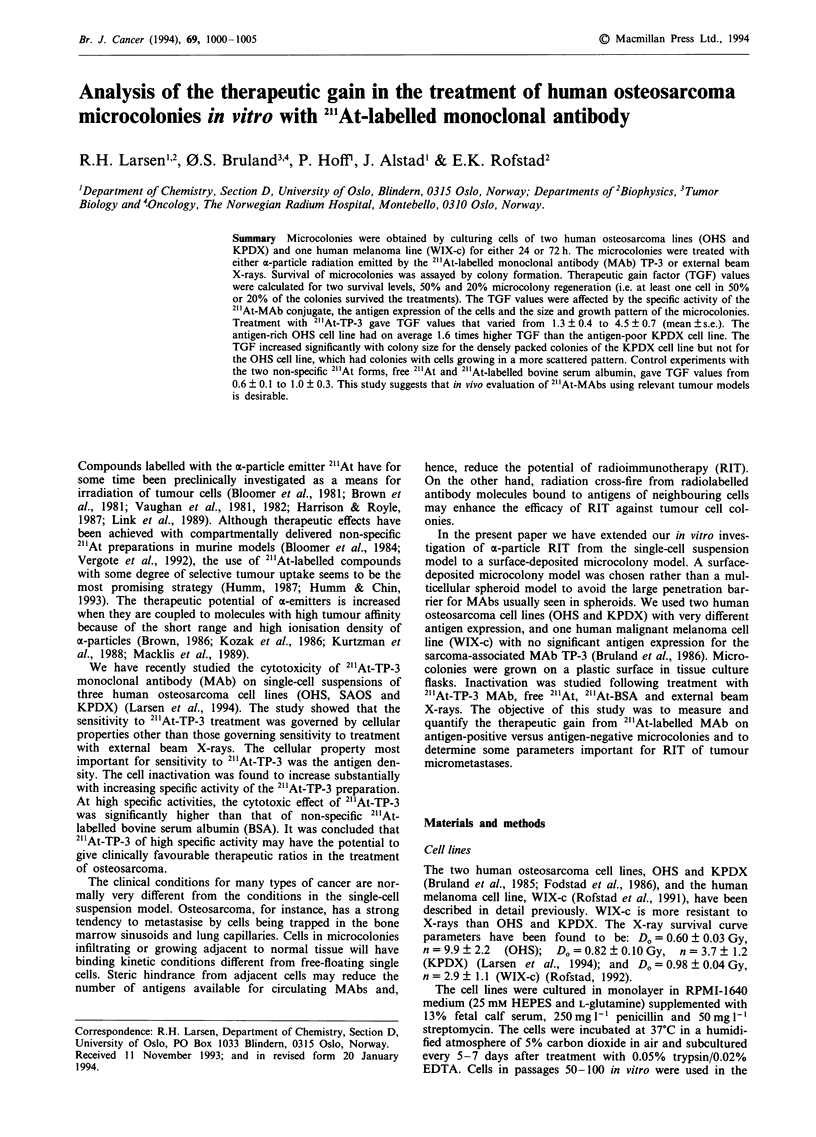
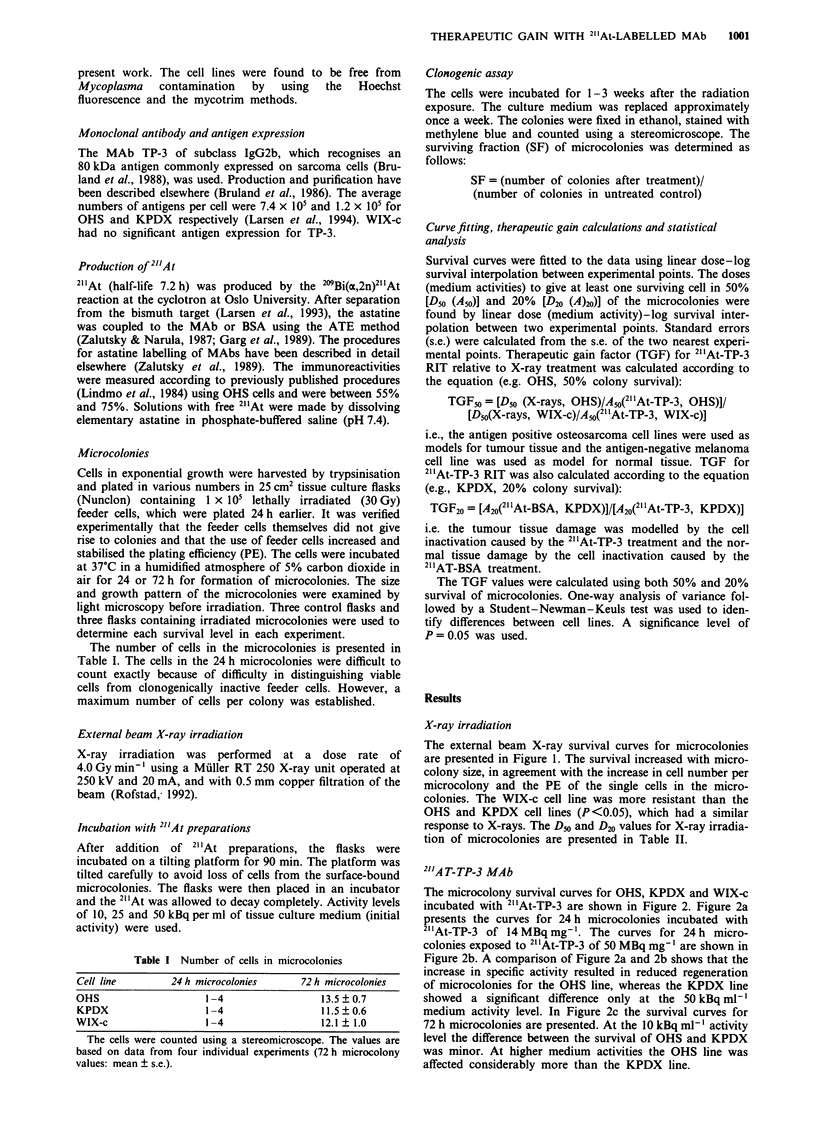
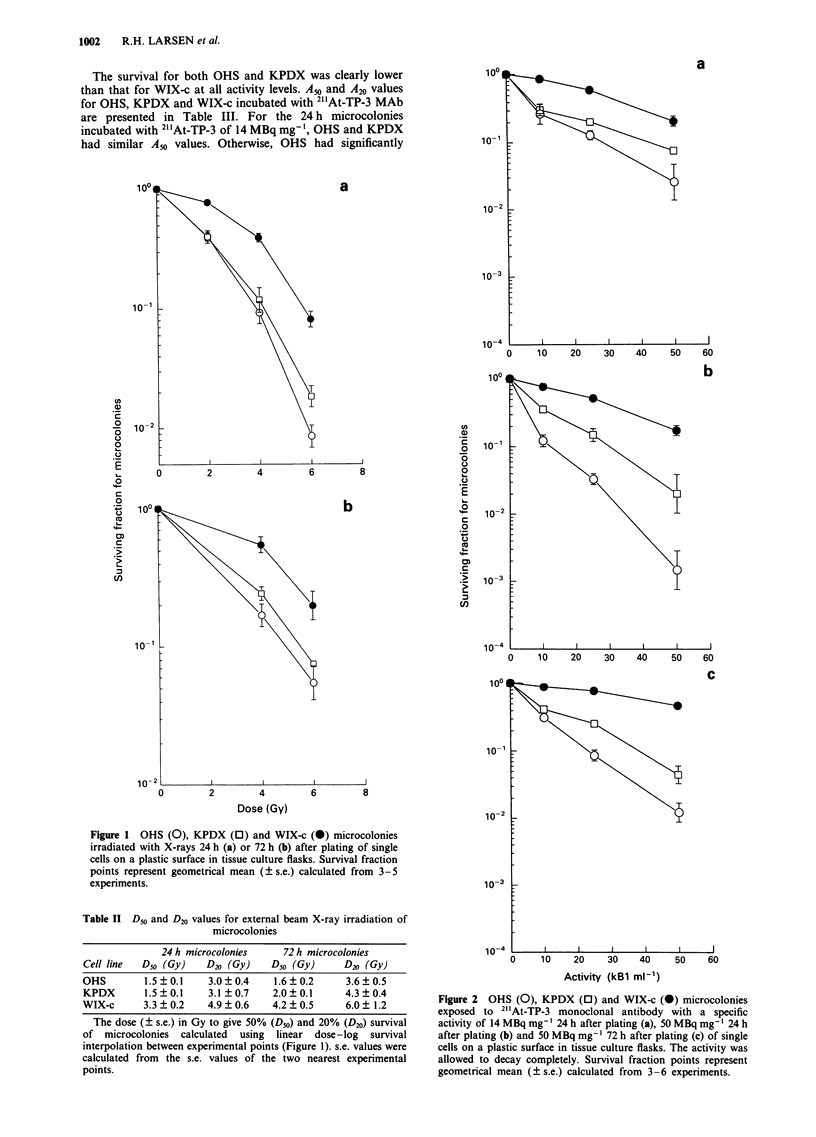
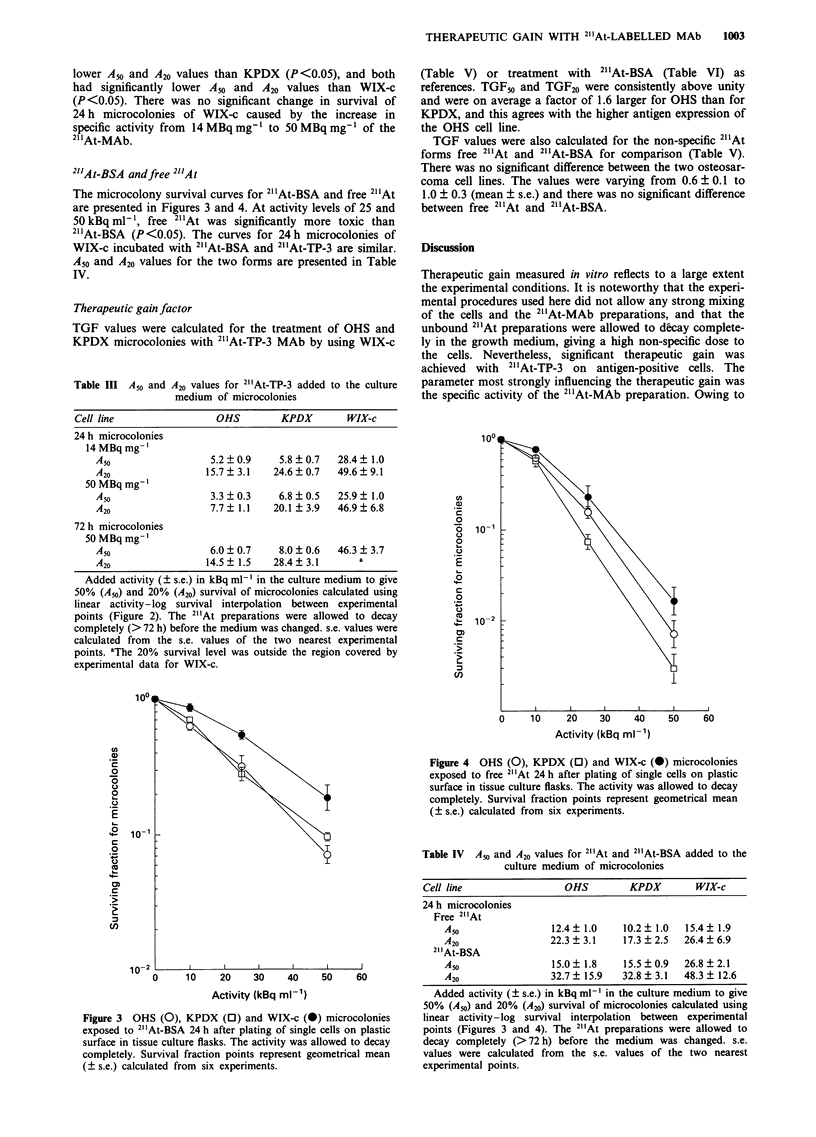
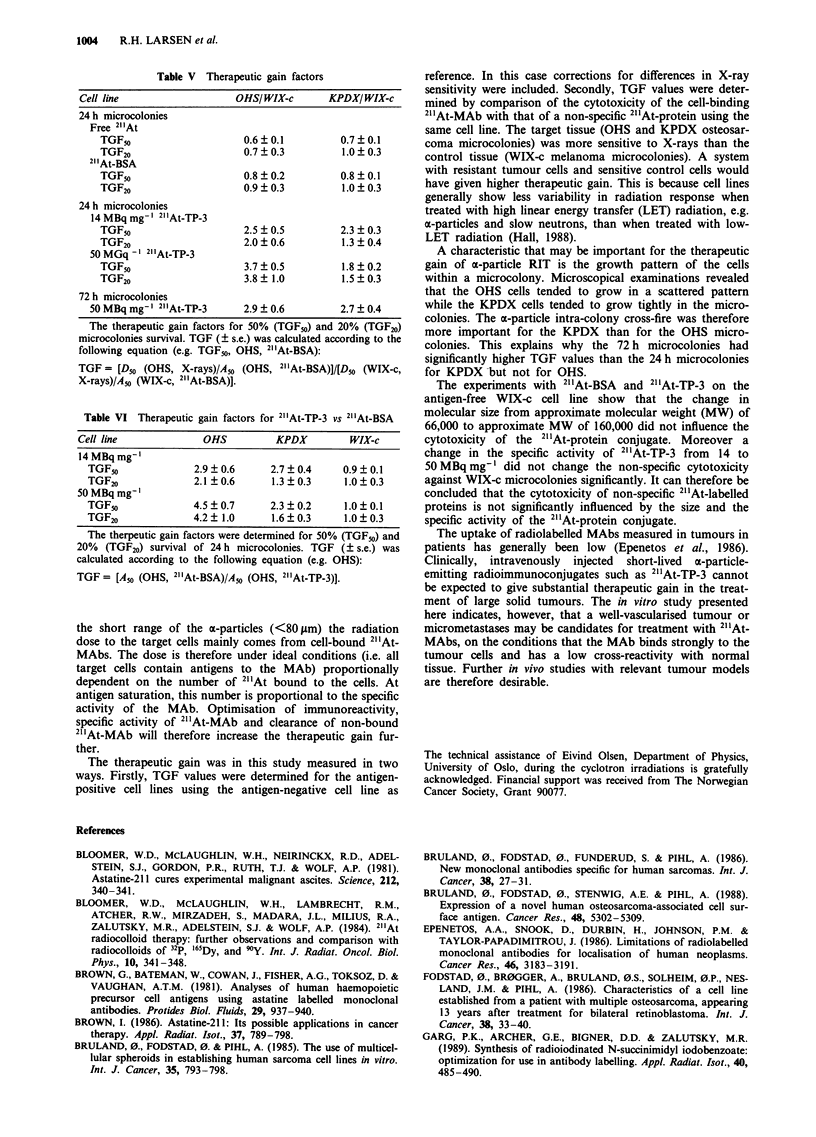
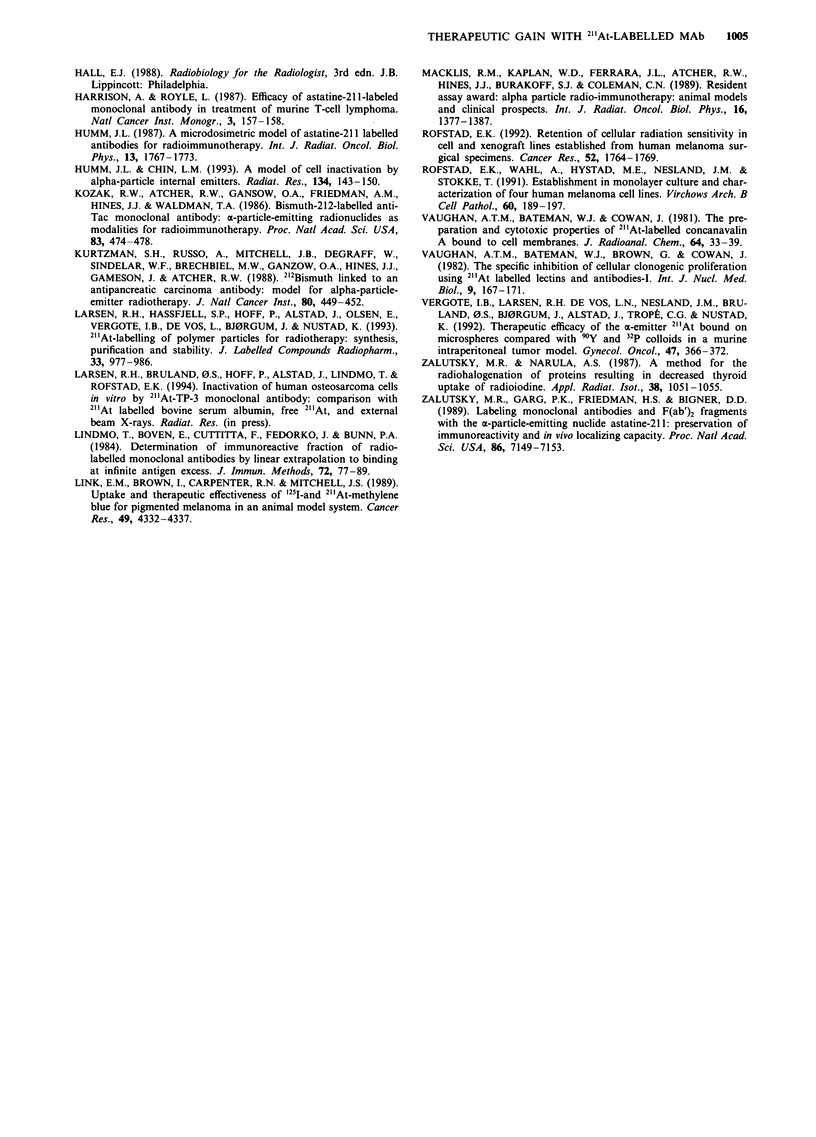
Selected References
These references are in PubMed. This may not be the complete list of references from this article.
- Bloomer W. D., McLaughlin W. H., Lambrecht R. M., Atcher R. W., Mirzadeh S., Madara J. L., Milius R. A., Zalutsky M. R., Adelstein S. J., Wolf A. P. 211At radiocolloid therapy: further observations and comparison with radiocolloids of 32P, 165Dy, and 90Y. Int J Radiat Oncol Biol Phys. 1984 Mar;10(3):341–348. doi: 10.1016/0360-3016(84)90052-x. [DOI] [PubMed] [Google Scholar]
- Bloomer W. D., McLaughlin W. H., Neirinckx R. D., Adelstein S. J., Gordon P. R., Ruth T. J., Wolf A. P. Astatine-211--tellurium radiocolloid cures experimental malignant ascites. Science. 1981 Apr 17;212(4492):340–341. doi: 10.1126/science.7209534. [DOI] [PubMed] [Google Scholar]
- Brown I. Astatine-211: its possible applications in cancer therapy. Int J Rad Appl Instrum A. 1986;37(8):789–798. doi: 10.1016/0883-2889(86)90273-x. [DOI] [PubMed] [Google Scholar]
- Bruland O. S., Fodstad O., Stenwig A. E., Pihl A. Expression and characteristics of a novel human osteosarcoma-associated cell surface antigen. Cancer Res. 1988 Sep 15;48(18):5302–5309. [PubMed] [Google Scholar]
- Bruland O., Fodstad O., Funderud S., Pihl A. New monoclonal antibodies specific for human sarcomas. Int J Cancer. 1986 Jul 15;38(1):27–31. doi: 10.1002/ijc.2910380106. [DOI] [PubMed] [Google Scholar]
- Bruland O., Fodstad O., Pihl A. The use of multicellular spheroids in establishing human sarcoma cell lines in vitro. Int J Cancer. 1985 Jun 15;35(6):793–798. doi: 10.1002/ijc.2910350616. [DOI] [PubMed] [Google Scholar]
- Epenetos A. A., Snook D., Durbin H., Johnson P. M., Taylor-Papadimitriou J. Limitations of radiolabeled monoclonal antibodies for localization of human neoplasms. Cancer Res. 1986 Jun;46(6):3183–3191. [PubMed] [Google Scholar]
- Fodstad O., Brøgger A., Bruland O., Solheim O. P., Nesland J. M., Pihl A. Characteristics of a cell line established from a patient with multiple osteosarcoma, appearing 13 years after treatment for bilateral retinoblastoma. Int J Cancer. 1986 Jul 15;38(1):33–40. doi: 10.1002/ijc.2910380107. [DOI] [PubMed] [Google Scholar]
- Garg P. K., Archer G. E., Jr, Bigner D. D., Zalutsky M. R. Synthesis of radioiodinated N-succinimidyl iodobenzoate: optimization for use in antibody labelling. Int J Rad Appl Instrum A. 1989;40(6):485–490. doi: 10.1016/0883-2889(89)90131-7. [DOI] [PubMed] [Google Scholar]
- Harrison A., Royle L. Efficacy of astatine-211-labeled monoclonal antibody in treatment of murine T-cell lymphoma. NCI Monogr. 1987;(3):157–158. [PubMed] [Google Scholar]
- Humm J. L. A microdosimetric model of astatine-211 labeled antibodies for radioimmunotherapy. Int J Radiat Oncol Biol Phys. 1987 Nov;13(11):1767–1773. doi: 10.1016/0360-3016(87)90176-3. [DOI] [PubMed] [Google Scholar]
- Humm J. L., Chin L. M. A model of cell inactivation by alpha-particle internal emitters. Radiat Res. 1993 May;134(2):143–150. [PubMed] [Google Scholar]
- Kozak R. W., Atcher R. W., Gansow O. A., Friedman A. M., Hines J. J., Waldmann T. A. Bismuth-212-labeled anti-Tac monoclonal antibody: alpha-particle-emitting radionuclides as modalities for radioimmunotherapy. Proc Natl Acad Sci U S A. 1986 Jan;83(2):474–478. doi: 10.1073/pnas.83.2.474. [DOI] [PMC free article] [PubMed] [Google Scholar]
- Kurtzman S. H., Russo A., Mitchell J. B., DeGraff W., Sindelar W. F., Brechbiel M. W., Gansow O. A., Friedman A. M., Hines J. J., Gamson J. 212Bismuth linked to an antipancreatic carcinoma antibody: model for alpha-particle-emitter radioimmunotherapy. J Natl Cancer Inst. 1988 May 18;80(6):449–452. doi: 10.1093/jnci/80.6.449. [DOI] [PubMed] [Google Scholar]
- Lindmo T., Boven E., Cuttitta F., Fedorko J., Bunn P. A., Jr Determination of the immunoreactive fraction of radiolabeled monoclonal antibodies by linear extrapolation to binding at infinite antigen excess. J Immunol Methods. 1984 Aug 3;72(1):77–89. doi: 10.1016/0022-1759(84)90435-6. [DOI] [PubMed] [Google Scholar]
- Link E. M., Brown I., Carpenter R. N., Mitchell J. S. Uptake and therapeutic effectiveness of 125I- and 211At-methylene blue for pigmented melanoma in an animal model system. Cancer Res. 1989 Aug 1;49(15):4332–4337. [PubMed] [Google Scholar]
- Macklis R. M., Kaplan W. D., Ferrara J. L., Atcher R. W., Hines J. J., Burakoff S. J., Coleman C. N. Alpha particle radio-immunotherapy: animal models and clinical prospects. Int J Radiat Oncol Biol Phys. 1989 Jun;16(6):1377–1387. doi: 10.1016/0360-3016(89)90938-3. [DOI] [PubMed] [Google Scholar]
- Rofstad E. K. Retention of cellular radiation sensitivity in cell and xenograft lines established from human melanoma surgical specimens. Cancer Res. 1992 Apr 1;52(7):1764–1769. [PubMed] [Google Scholar]
- Rofstad E. K., Wahl A., Hystad M. E., Nesland J. M., Stokke T. Establishment in monolayer culture and characterization of four human melanoma cell lines. Virchows Arch B Cell Pathol Incl Mol Pathol. 1991;60(3):189–197. doi: 10.1007/BF02899546. [DOI] [PubMed] [Google Scholar]
- Vaughan A. T., Bateman W. J., Brown G., Cowan J. The specific inhibition of cellular clonogenic proliferation using 211At labelled lectins and antibodies--I. Int J Nucl Med Biol. 1982;9(3):167–171. doi: 10.1016/0047-0740(82)90091-2. [DOI] [PubMed] [Google Scholar]
- Vergote I., Larsen R. H., de Vos L., Nesland J. M., Bruland O., Bjørgum J., Alstad J., Tropé C., Nustad K. Therapeutic efficacy of the alpha-emitter 211At bound on microspheres compared with 90Y and 32P colloids in a murine intraperitoneal tumor model. Gynecol Oncol. 1992 Dec;47(3):366–372. doi: 10.1016/0090-8258(92)90141-5. [DOI] [PubMed] [Google Scholar]
- Zalutsky M. R., Garg P. K., Friedman H. S., Bigner D. D. Labeling monoclonal antibodies and F(ab')2 fragments with the alpha-particle-emitting nuclide astatine-211: preservation of immunoreactivity and in vivo localizing capacity. Proc Natl Acad Sci U S A. 1989 Sep;86(18):7149–7153. doi: 10.1073/pnas.86.18.7149. [DOI] [PMC free article] [PubMed] [Google Scholar]
- Zalutsky M. R., Narula A. S. A method for the radiohalogenation of proteins resulting in decreased thyroid uptake of radioiodine. Int J Rad Appl Instrum A. 1987;38(12):1051–1055. doi: 10.1016/0883-2889(87)90069-4. [DOI] [PubMed] [Google Scholar]


